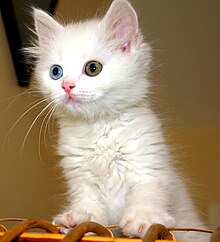Van cat: Difference between revisions
Removing "formerly Kurdistan". This region was never formerly Kurdistan. |
SMcCandlish (talk | contribs) |
||
| Line 9: | Line 9: | ||
| altname = Cat of Van, ''Van Kedisi'' |
| altname = Cat of Van, ''Van Kedisi'' |
||
| nickname = |
| nickname = |
||
| country = [[Lake Van]] area, [[Turkey]] |
| country = [[Lake Van]] area, [[Turkey]] (formerly [[Armenia]] & [[Kurdistan]]) |
||
| cfastd = |
| cfastd = |
||
| fifestd = |
| fifestd = |
||
Revision as of 08:46, 23 February 2012
It has been suggested that this article be merged into Turkish Van. (Discuss) Proposed since May 2009. |
It has been suggested that Van Cat naming controversy be merged into this article. (Discuss) Proposed since September 2009. |
This article needs additional citations for verification. (March 2008) |
| Van Cat | |
|---|---|
 A typical odd-eyed Van Cat kitten. | |
| Other names | Cat of Van, Van Kedisi |
| Origin | Lake Van area, Turkey (formerly Armenia & Kurdistan) |
| Breed standards | |
| TICA | standard |
| Domestic cat (Felis catus) | |
The Van Cat (Turkish: Van kedisi, "Cat of Van") is a distinctive breed of domestic cat found mainly in the Lake Van region of modern-day eastern Turkey. It is large, all-white, and frequently odd eyed.[1] The Van Cat is a natural breed, and is basis of the internationally selectively bred Turkish Van breed, with a more recently developed ruddy coloring pattern on the white, as standardised and recognised by many cat fancier organisations. Some registries, including The International Cat Association (TICA), along with the Turkish government, consider the Van Cat and Turkish Van to be the same breed.
History
The Van Cat has been reported living in the vicinity of the city of Van for centuries, and medieval sources mention white cats as being one of the exports of the Van region. The cats are named Van kedisi in Turkish[2], Vana katou or Vana gadou in Armenian (Armenian: վանա կատու) [3][4], and pisîka Wanê in Kurdish [5]; each literally translates to Cat of Van.
At the end of the 19th century, Sultan Abdul Hamid II is said to have owned a Van Cat, and owning a Van Cat is still seen as a status symbol: a Prime Minister of Turkey received one as a gift, and an ambassador from Greece put himself on a waiting list to get one. Kittens for the breeding center could be purchased for $30 in 2006, but their export from Turkey is theoretically outlawed (with a reported fine of $50,000).[citation needed]
During the late 1990s the Van Cat emerged as an informal municipal symbol of the city of Van – an enormous statue of a Van Cat and kitten now stands at the entrance to the city, and the cat appears in a local comic strip, and in the logos of bus companies, shopping centres, various businesses, etc. Ironically, this paralleled a serious decline in Van Cat numbers.
A Van Cat naming controversy has arisen, with the breed claimed as something akin to cultural property by Turks, Kurds and Armenians.
Characteristics
The cats are notable for their lean, long-legged appearance. They are reported to like water more than most cats, and have been seen swimming in Lake Van. Their most notable genetic characteristic is their almond-shaped eyes that often are mismatched colors. The most valued and valuable members of the breed generally have one amber-green eye and one blue eye.
Current status

In the mid-1990s the "Van Cat House", a Van Cat breeding and research center, was established within the campus of Van University (Van Yüzüncü Yıl Universitesi / Van Hundredth Year University). However, reports [1] have revealed that the living conditions for the cats held there leaves much to be desired, and the breeding program seems to be ineffective in reversing the Van Cats’ declining numbers. As of 2006[update], the center housed about 100 young adults and kittens, and is open to the public for a nominal entrance fee.[6]
To increase the population of the Van Cat, the local government of Van instituted a program which would pay residents the equivalent of $200.00 per month to keep one. This program was discontinued by a later government.
In popular culture
The mascot of the 2010 FIBA World Championship of basketball, hosted by Turkey, was an anthropomorphized Van Cat named "Bascat". He had a white coat and odd eyes, one blue and one green, and his head was altered to take design cues from the crescent moon on the Turkish flag.[7]
References
- ^ a b http://newspot.byegm.gov.tr/2006/february/ns11.htm [dead link]
- ^ "Van Cat". Official website of the Republic of Turkey Ministry of Culture & Tourism. Republic of Turkey Ministry of Culture and Tourism. p. 2005. Archived from the original on 2007-09-29. Retrieved 2009-07-15.
- ^ Paruyr Sevak, "The Unsilenceable Belfry" (Պարույր Սևակ, ԱՆԼՌԵԼԻ ԶԱՆԳԱԿԱՏՈՒՆ), published in 1959: "...Թե՞ ազատվելու հուսահատ ճիգով Լող էին տալիս հազա՜ր ու հազա՜ր Վանա կատուներ՝Վառվող աչքերով ...
- ^ "Armenian Vans - Real "Aristocrats"". Tour Armenia. TACentral.com. Retrieved 2009-07-17.
- ^ Sor, Dara (11 January 2006). "Kurdish National Pride: Pişika Wanê - The Van Cat". Land of the Sun: Kurdistan. BlogSpot. Retrieved 2011-12-13.
- ^ Most of the above information is contained in "Van City Guide", Ankara, 2005.
- ^ "2010 FIBA World Championship Event Guide: Mascot". FIBA. Retrieved 2010-09-12.
- "Van, Turkish Republic Ministry of Culture information book 62", Ankara 1994.
- "Van City Guide", Ankara, 2005.
- "Van", Gezi pocket guides, Istanbul, 2004.
- Travel Guide to Turkey
- Turkish cat; dazzling beauty from the oriental culture.
External links
- Van cat at the Republic of Turkey Ministry of Culture and Tourism website.
- VanCat.org - a website about Van Cats.
